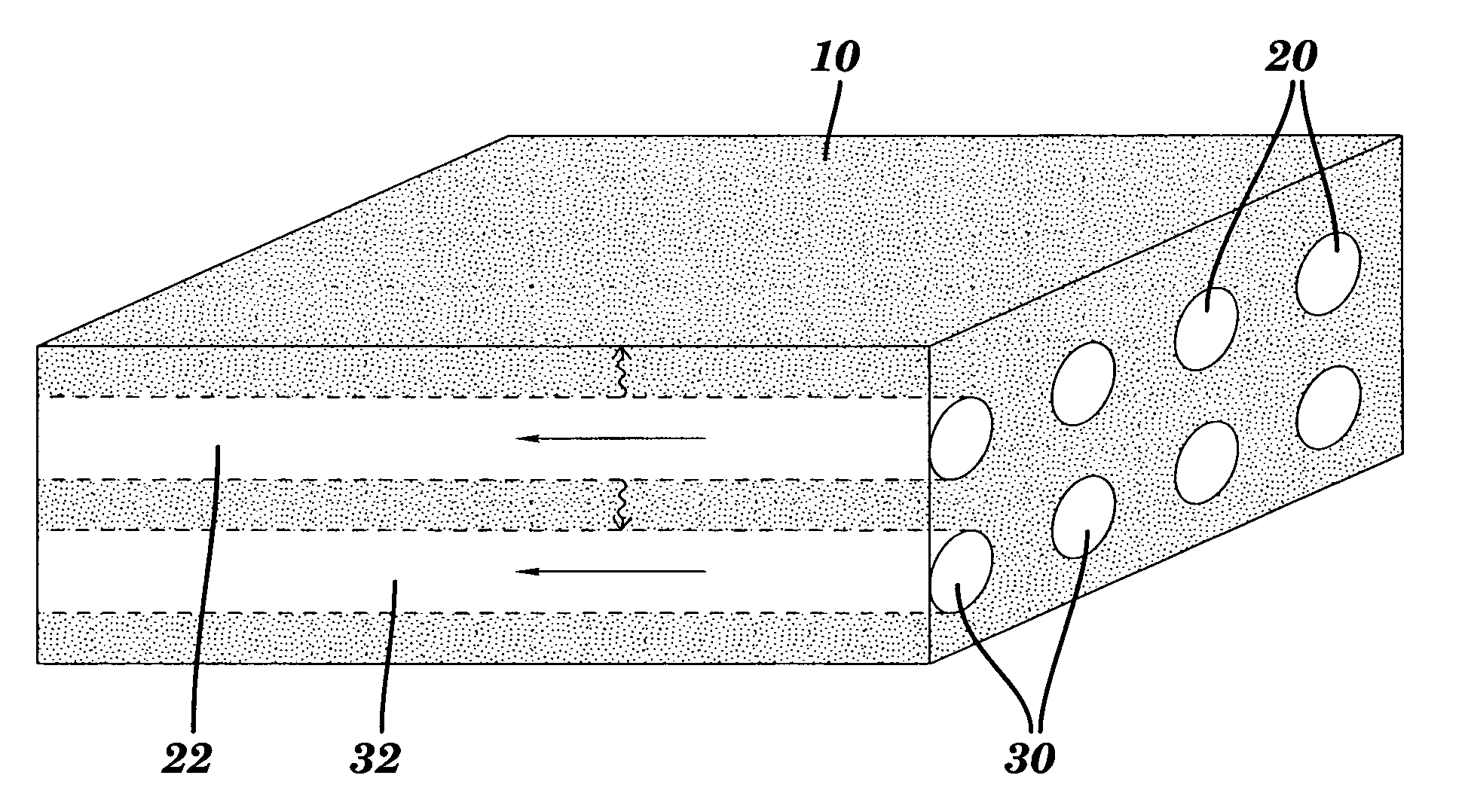Diffusively permeable monolithic biomaterial with embedded microfluidic channels
a monolithic biomaterial, diffusively permeable technology, applied in the direction of prosthesis, bandages, dressings, etc., can solve the problems of limited use, limited use, and limited use, and achieve the effect of facilitating wound healing
- Summary
- Abstract
- Description
- Claims
- Application Information
AI Technical Summary
Benefits of technology
Problems solved by technology
Method used
Image
Examples
example 1
Fabrication of a Monolithic Biomaterial
[0100] A monolithic biomaterial was fabricated having a microfluidic system entirely within calcium alginate (4% [w / v]), a versatile hydrogel. As used herein this monolithic biomaterial is also referred to as a “microfluidic biomaterial” and abbreviated as “μFBM.” Control of mass transfer within the ρFBM was demonstrated, and the μFBM was shown to be (i) appropriate for replication of the microstructure, (ii) formable into pressure-tight fluidic structures, and (iii) highly permeable to the diffusion of small and large solutes. The sealed microfluidic structure were formed to have channels that are 100 μm wide by 200 μm deep; sealed channels were formed with cross-sectional dimensions as small as 25 μm×25 μm.
[0101] Three modes of operation have been used to characterize the transfer of solute in μFBMs. In all cases, the device was submerged in a stirred reservoir (200 mL; ur˜1 cm / s) of aqueous buffer in which the solute of interest is dilute ...
example 3
Analysis of Mass Transfer in μFBM
Mass Transfer Conditions for All Experiments
[0114] The analysis and the operation of the μFBM (of Example 1) are greatly simplified at sufficiently high flow rates, where the bulk concentrations in the reservoir and the channels alone determine the concentration gradients driving the diffusion process. This condition is satisfied when the Biot numbers in both the reservoir and the channels are large, and the Peclêt number in the channels is large. The Biot number is defined as the ratio of the rate of mass transfer into the flow to the rate of diffusive mass transfer through the material, and isBi=kHDs / gel;
the Peclêt number is defined as the ratio of the rate of mass transfer with the flow to the rate of diffusion within the flow, and is Pe=uchDs / liq
(Welty et al., Fundamentals of Momentum, Heat, and Mass Transfer (2000), which is hereby incorporated by reference in its entirety). Here, Ds / gel and Ds / liq are the molecular diffusivities of the s...
example 4
Formation of Macroscopic, Three-Dimensional Scaffolds by Injection Molding of Alginate with Embedded Chondrocytes
[0117] The appropriateness of alginate gels as scaffolds for 3D cultures of chondrocytes has been documented (Hauselmann et al., Journal of Cell Science 107:17-27 (1994), which is hereby incorporated by reference in its entirety). The chondrocytes are fully embedded in the gel by creating a suspension prior to gelation; gelation is induced by the infusion of calcium ions. It has been demonstrated that injection molding of the pre-gel suspension allows for the formation of scaffolds with well-defined 3-D shape of macroscopic dimension (>1 cm) (Chang et al., J. Biomed. Mat. Res. 55:503-511 (2001) and Chang et al., Plastic and Reconstructive Surgery 112:793-799 (2003), which are hereby incorporated by reference in their entirety). As discussed below, this method involves the -following steps: (i) isolation of chondrocytes; (ii) construction of molds; (iii) cell suspension i...
PUM
| Property | Measurement | Unit |
|---|---|---|
| Width | aaaaa | aaaaa |
| Width | aaaaa | aaaaa |
| Height | aaaaa | aaaaa |
Abstract
Description
Claims
Application Information
 Login to View More
Login to View More - R&D
- Intellectual Property
- Life Sciences
- Materials
- Tech Scout
- Unparalleled Data Quality
- Higher Quality Content
- 60% Fewer Hallucinations
Browse by: Latest US Patents, China's latest patents, Technical Efficacy Thesaurus, Application Domain, Technology Topic, Popular Technical Reports.
© 2025 PatSnap. All rights reserved.Legal|Privacy policy|Modern Slavery Act Transparency Statement|Sitemap|About US| Contact US: help@patsnap.com



